Caracciolo class battleships (1917)
 Italy – Regia Marina: RN Francesco Caracciolo, Marcantonio Colonna, Cristoforo Colombo, Francesco Morosini (1914-1921)
Italy – Regia Marina: RN Francesco Caracciolo, Marcantonio Colonna, Cristoforo Colombo, Francesco Morosini (1914-1921)
The first Italian Fast Battleships
The last class of Italian dreadnoughts conceived before the war was the Caracciolo class, started in 1914-15. They were radically new battleships, much faster and heavily armed: They presented the new generation of Italian ‘super dreadnought’ and first fast battleships, but were condemned by the Washington treaty. Because of war priorities, none was completed and they had to be broken up after the Washington treaty was signed, despite completion projects, notably as an aircraft carrier conversion.
Development
When the Washington Treaty was ratified in 1923, it put an end to an industrial and military escalation started in 1913, towards even faster and better-armed dreadnoughts. Italy was no exception to the rule. In 1916, her last dreadnought to enter service, the Doria class, was only equipped with 12-in guns and limited to 21 knots. But the Royal Navy with its five Queen Elizabeth in 1913 and later confirmed with the five Revenge launched in 1915, all armed 6-in guns (381 mm) and capable of 23 knots with oil-burn for better range and seemed to lead the pack in Battleship design. Conscious of this fact, the Italian admiralty already in 1914 (Italy was still neutral at this point and both the British and French were potential adversaries) ordered a study as early as 1914. The new new project was intended to give some parity with to the Royal Navy and the study was conducted by Chief Engineer Rear Admiral Edgardo Ferrati.
The 1911 Italian super-dreadnought competition
pic
pic
But even further back in time, in 1911, Chief of Staff Vice Admiral Giovanni Bettolo and the Minister of the Navy, Vice Admiral Pasquale Leonardi Cattolica announced a competition for a “super-dreadnought” design. The basic characteristics concerned a 35,000 tons standard ship, which was quite ambitious for the time, with a top speed of no less than 28 knots speed, and and armament of twelve 381 mm (15 inches) and twenty 152 mm (6 inches) guns. Nothing was said about the armor, which was likely lighter than contemporaty designs in order to reach the desired speed, and in the tendency of the time.
The Ansaldo shipyards (Sestri Ponente), the Orlando Yards of and the Odero shipyard also of Livorno, the only ones with drydocks large enough, took part in the competition. The Regia Marina reunited all the major generals around Naval Engineers Edgardo Ferrati and Agostino Carpi. The reunion was also attended by colonels G.N. Giuseppe Rota and Gioacchino Russo. After a careful examination of the projects, Major General Ferrati was entrusted with making the preliminary draft. He had to work, keeping in mind the various solutions presented and attempting to make a fusion of these proposals.
The definitive draft was ready in December 1913. For practicity reasons, and to rationalize protection, the initial top speed of 28 knots was maintained by the displacement was reduced to 30,900 tons, the armament to eight 381 (15 in) in four twin main turrets. For the secondary, it was reduced to eighteen 152mm adnd completed by twenty-four 76 (3-in) guns for anti-torpedo warfare as well as eight torpedo tubes of 450 mm (18 in), all fixed.
The design is drastically scaled down in 1913
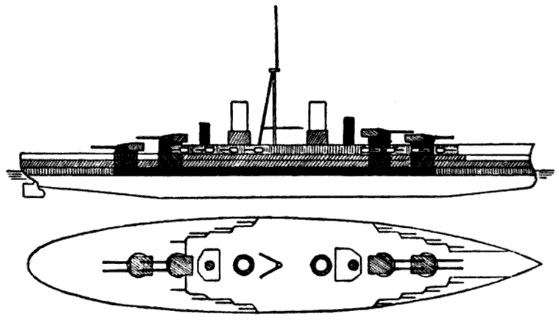
The first plan calling a battleship armed with no less than twelve 381 mm (16-in) distributed in four triple turrets and twenty 6-in barbettes guns if completed in 1917, would have been the most powerful warships in the world. But this project was visibly too ambitious for the means of the Regia Marina’s limited budget. It was drastically scaled down. The second project had twin turrets, resulting in smaller barbette and thus, a narrower and short hull. It enabled to scale down the ship considerably, towards a more classic equivalent of the Queen Elisabeth class.
Among its specificities, the 6-in (152 mm) adopted as a secondary caliber and four inches (102 mm) rather than 3-in (76 mm) for the QF guns mounted on top of the turrets, were completed by 2-pdr (40 mm) rapid fire anti-aircraft mounts. These were wise, even avant-garde choices for the Italian Navy, giving the initial design the best AA protection of any warship at the time. However in 1914 it was recoignised that the “all-in the citadel” protection motto was a danegrous one, and that speed could be curtailed a bit if allowing to significantly reinforcement armor overall, alongside a revised torpedo armament distribution, less ambitious but more rational.
Eng. Orlando’s fast alt battleship design, 1913
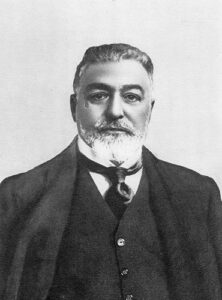 Knowing that the “grandi ammiragli” class battleships design was still not fixed, engineer Giuseppe Orlando (his father Luigi was even perhaps more famous) redacted in his hotel’s invoice and notes, and drafted his own proposal for the Odero-Terni yard he directed. He also worked at La Spezia with Vickers, adapting many armaments designs.
Knowing that the “grandi ammiragli” class battleships design was still not fixed, engineer Giuseppe Orlando (his father Luigi was even perhaps more famous) redacted in his hotel’s invoice and notes, and drafted his own proposal for the Odero-Terni yard he directed. He also worked at La Spezia with Vickers, adapting many armaments designs.
src: stefsap site (see credits/src at the end of the article)
Design Approval in 1914 of the “grandi ammiragli”
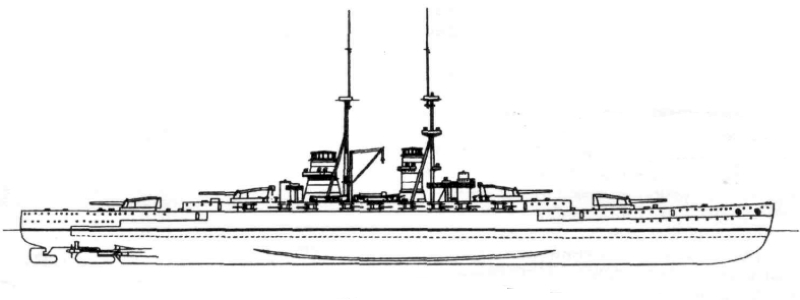
After the approval by new Chief of Staff Vice Admiral Paolo Thaon di Revel in 1912, construction of the four new battleship was started, preceded by a more refined design.
Shortly before the start of construction of Francesco Caracciolo in October 1914, it was decided protect the forward area of the ships (beyond the citadel) with a 150 mm vertical armour over two bridges in height. There were also last-minutes changes in 1914, as the displacement rose to 31,400 tons. The secondary armament lost six guns, and the 76mm/40 Mod. 1916 R.M. were replaced by lighter and faster Vickers-Armstrong QF 2 lb automatic QF guns manufactured in Italy under licence.
The names were also in balance: The four Francesco Caracciolo class were prior to their renaming known as the “Grandi Ammiragli” (“great admirals”) when ordered in 1914. The lead ship was eventually ordered on 12 October at the Royal Naval Shipyard of Castellammare di Stabia, the most trusted and prestigious of the Regia Marina and work started with the keel laying ceremony on the next 16 October. By June 1915, work started at last on the remaining three which by consequences would end as the least advanced of the class. But they were launched anyway.
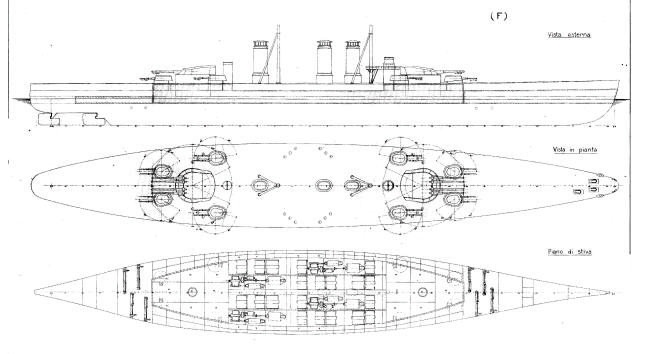
General Ferrati ‘F’ 1915 alternative proposal for a quadruple turrets battleship SOURCE. By that time the initial design had been approved. These were possibly applied to a better protected successors of the Ammiragli, to be started in 1916 when the docks would be free and the launched vessels in completion.
Construction
The keel of the first ship was laid in Castellamare di Stabia in October 1914 and construction went on well, while three other keels (Cristoforo Colombo, Marcantonio Colonna, and Francesco Morosini) were laid in Ansaldo, Odero and Orlando yards respectively in March and June 1915. But as soon as the war broke out, it seemed impossible to complete them, due to the lack of manpower and resources. After a while construction was halted entirely.
Francesco Caracciolo: Regio Cantiere di Castellammare di Stabia -Naples. 16 October 1914. Launched 12 May 1920: Cancelled on 2 January 1921
Marcantonio Colonna: Cantieri navali Odero -Genoa-Sestri Ponente. 3 March 1915. Never launched, BU on slip 1921.
Cristoforo Colombo: Ansaldo, Genoa. 14 March 1915. Never launched, BU on slip 1921.
Francesco Morosini: Cantiere navale fratelli Orlando (Livorno) 27 June 1915. Never launched, BU on slip 1921.
Apart Colomb which was an explorator, the remainder three were renown renaissance admirals.
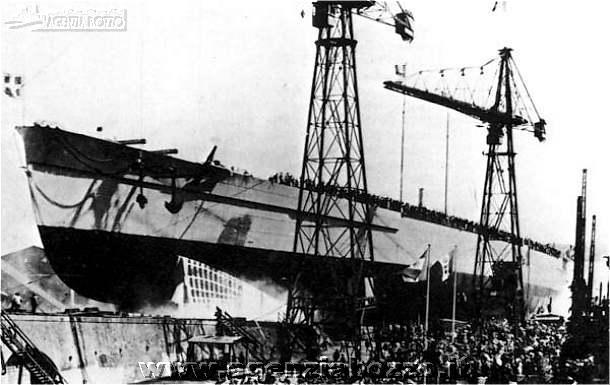
Launch of the Caracciolo in October 1920

Whatif rendition of the caracciolo SOURCE
Design of the class
Since the start, requirements had the final design down to eight main guns, 381 mm caliber, and to 31,000 tons. Water tank trials conducted in La Spezia helped identifying the best hull shapes, and scale models were use to also test the best underwater protection. This process in fact went one even after the construction was ordered and helped furtther refining the underwater protection as well. Venica arsenal was put in charge of testing indeed the horizontal protection and La Spezia for the oil boilers and connected pipes, so changed were made also to the machinery spaces design to the last minute.
The final drawings were approved in December 1914 and setup overa a 30,900 tons design (standard) but a revised secondary battery of eighteen 6-in/50 QF guns, twenty-four 3-in QF guns and still eight torpedo tubes, plus a still “light” 300 down to 220 mm vertical armor(but with sloped sections, layered armor made of Krupp cemented plating) and just 35+16 mm horizontal armor (that is deck armor) with a final revised underwater protection which integrated a main 24 mm longitudinal bulkhead and 10 mm layers for the crush tubes and inner compartment separating the machinery spaces from the hull. Additional protection close to the bow section comprised two 2 levels of 150 mm thick plating, which rose the displacement and obliged to removed some artillery and TTs.
Hull and general design
The Francesco Caracciolo class was 201.6 m (661 ft) long (waterline), 212 m (696 ft) overall combined with a beam of 29.6 m (97 ft) making for a favourable lenght-to-beam ration for speed. This was helped by the twin turret barbettes. The mean draft was calculated at 9.5 m (31 ft). Displacement as planned was 31,400 metric tons (30,900 long tons) normal load but 34,000 t (33,000 long tons) fully loaded. This was well below the Washington treaty limits.
As for the way the main armament was staged and superstructures kept to the mininum, which wa caracteritic of Italian capital ships: The bridge was compact, with a short tower composed of the conning tower and a two-story structure above supporting the main telemeter and fire control system. The small bridge was a rapported piece in front of the conning tower, just above “B” turret’s roof line. They were to be equipped with two tripod masts, although some designers, like Orlando, professed the idea of corbel or lattice masts. The two tripods were of equal height and size, the foremast supporting a spotting top and two projectors, and the main mast, located just in front of the aft funnel (which was shorter than the forefunnel) supported the rear spotting top.
The estimated crew comprised 40 officers and 1,200 ratings. There were around six service boats located in between funnels, served with an axial crane, with probably more planned under davits (location unknown). But the real innovation of the design was the placement of the main turrets: In 1914, the initial design shown a classic superfiring arrangement with the two pairs relatively close together like the previous Doria class. However as the construction was well engaged in 1915, last minute changes were operated, confirmed past-mid 1916 and shown in the final draft in 1919: The four barbettes had been moved far apart of each others.
The driving idea was to keep themelves widely separated for security reasons: If one was hit, the fire could spread in theory in the second one, destriying half the armament in one go. By spreading the turrets this way, this was less likely. Similar design solutions were also chosen in Germany as shown by the caracteristic aft turrets far apart of late battlecruisers. “B” and “X” turrets therefore were placed not in barbettes but in superstructures, which was needed to increase accomodations, and added the benefit of a supplementary protection around the barbettes.
It should be said by keeping the turrets closer together, engineers could have saved armour weight by considerably reducing the citadel’s lenght, and thus reinforced it considerably, possibly reaching 350-360 mm instead of 300 and making it immune to same caliber instead of 12-in or 14-in caliber only. Would have it be worthwile in the end ? Between the use of sloped armor and Krupp Cemented plating, and due to the high speed requirement, the choice made in the end seemed valid at the time.
Powerplant
The Caracciolo class were to be powered by four Parsons steam turbines. They were built locally under licence. Each of these was driving a single shaft, with staged outer and inner pairs. As usual in this configuration, a play was made between lower and higher pressure turbines, the inner ones kept for cruising and the outer ones for speed. The turbines themelves had a double stage, of low and higher pressure.
Steam came from twenty oil-fired Yarrow type boilers. Their exhausts were trunked into two large funnels of various heights, equal in the 1914 design and anf with a taller forefunnel (and caps) in the revised 1919 design. The turbines were rated at 105,000 shaft horsepower (78,000 kW). This enabled a top speed of 28 knots (52 km/h; 32 mph). At economical speed of 10 knots range was still of 8,000 nautical miles (15,000 km; 9,200 mi), perfectly adequate for the Mediterranean. It was 4800 nm for the Doria class for example. It was in small part due to efficiency but moreover of a far larger fuel capacity given the larger hull and greater compartimentation. Keeping the same 20 boilers from the Doria to the Caracciolo, even all oil-fed (mixed on the Doria) did not explained the enormous output difference between the 30,000 shp of the former and 105,000 shp (more than trice as much !).
Both the turbines and boilers were larger, the latter being higher pressure and using superheated steam, in short more efficient overall. Indeed going from 21 to 28 knots was an enormous change, which proportionally forced the tripling of output given the also larger hull, from 23,000 to 32,000 tonnes standard, 9,000 tonnes more. In any circumstances 28 knots for a capital ship was considerable. This was five knots more than the British QE class, way more than the French planned Normandie class, and about the same as battlecruisers. This alone made the Caracciolo the first true “fast battleships” ever built, even if they were never completed. It could be argued that the German battlecruisers were so well protected that the 28-kts Mackensen class were equivalent to the Caracciolo in overall caracteristics, which included the main armament. Italy had at the same time started its next generation battleships as well as its first battlecruisers in the same package. They would have been certainly more relevant that the Doria/Cavour class in 1940, but postwar conditions completely changed the deal and we are left with conjectures.
Armour protection layout
As planned, Early 1915
The main armor was entirely made of Krupp cemented steel, manufactured under licence by Terni (Odero Yard, Sestri Ponente). The main belt armor reached 303 mm (11.9 in) only. The horizontal protection (armor deck and battery deck above) consisted of a 50 mm (2 in) thick deck, with a two-layered approach, a 35 mm (1.37 in) KCA main layer and a softer steel layer of 16 mm. The battery deck was proably only 16 mm (0.6 in) thick, as the weather deck.
The main conning tower was massive, both in height (she went down to the citadel and towered above the roofline of “B” turret) and thickness with walls 400 mm (16 in) thick. The same protection was applied to the main battery turrets with faces the same thickness (and slopes, making them immune to even 16-in caliber), the secondary casemate guns being protected by 220 mm (8.7 in) plating.
The vertical armor did not exceeded 300 mm, but the 30° slope artificially accentuated its thickness, although it was still weak against parabolic shells. The citadel was closed fore and aft by 220 mm (8.7 in) transverse bulkheads.
As revised 1917-19
In the meanwhile, war experience showed the importance of a good ASW defence and the designed was revised by adopting a common solution also chosen by the Royal Navy and derived from experiences conducted on old, discarded hulls. The solution chosen though was not as efficient as the one adopted by the Kaiserliche Marine, which was based on a larger large range of simulation, each time verifying the effects of the explosion on a 1:1 mock up hull.
The Jutland/Skagerrak experiences on long, parabolic fire also had an effect on revising the obviously insufficient horizontal protection still possible at this stage of contruction. This led to a further revision of the design but that that stage, forced to add the extra armour, 90-110 mm (3.5 – 4.3 in) directly over the weather deck. This enhanced the usual curved shape but this compromised stability. The barbettes where also increased up to 400 mm (300 mm before). The new protected deck was added to the same lateral protection still comprising a double layer of 300 and 220 mm in thickness, but the underwater protection remained whoefully insufficient. If these vessels would have been still around in 1941-42, they could have been defeated even by aerial torpedoes.
Armament
The main armament was unchanged basically since 1913 when fixed on only eight guns. The development of this ordnance however took time. Secondary armament was also revised and in 1914, the light armament took a far more AA or dual purpose coloration which was avant-guard for the time. The torpedo tubes were not however, but Jutland would soon relativise their utility.
Main
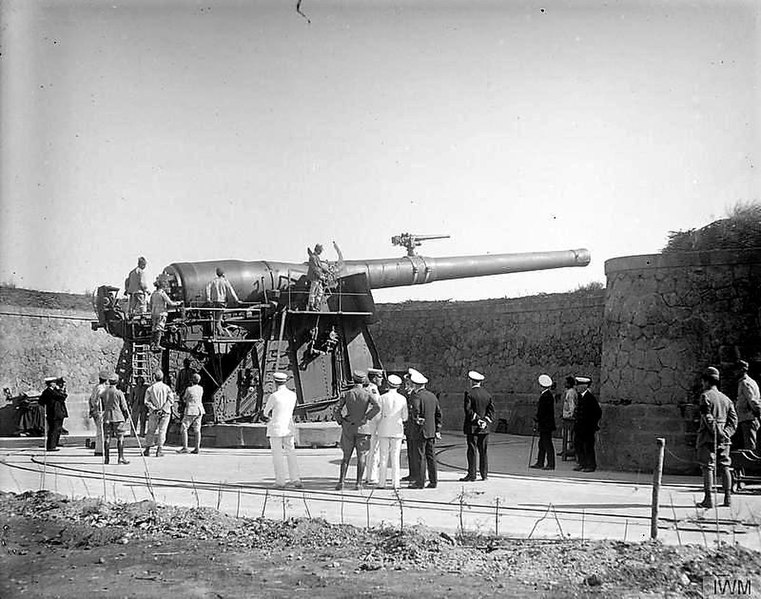
Francesco Caracciolo and her sisters had the same main battery of eight 40-caliber Cannone navale da 381/40 guns. They were located in in four twin gun turrets mounted on the centerline in “superfiring pairs” fore and aft, but pushed as the design progress further apart.
Italy planned four dreadnought battleships to succeed the two Andrea Doria with 381 mm (15 in) guns already in 1912 when the construction of the British Queen Elizabeth class was decided. Thirty guns were ordered in 1913 as soon as a proposition submitted to Ansaldo-Schneider, Armstrong-Pozzuoli, and Vickers-Terni. They all had identical ballistic performance, but differed in construction. The British Vickers-Terni in the end was the preffered design, and ten more ordered in 1914 from Armstrong-Pozzuoli. The Italo-French Ansaldo guns however were close contenders, weighing only 63 long tons (64 t) whereas the Armstrong’s 83.56 long tons.
The Cannone navale tested in 1913-1915 were 381mm/40 with a total overall length, barrel included, of 15.74 meters (51 ft 8 in), the barrel itself being 15.24 meters (50 ft) long. The propellant depending on the shell type was weighting between 148 or 150 kilograms (326 or 331 lb). Rate of fire depending on the loading angle and mount, circa one round per minute for the battleships guns. Indeed they were used instead on improvized monitor mounts and railways during the war. They fired a standard AP shell at 885-kilogram (1,951 lb) and 700 meters per second (2,300 ft/s), up to 19,800 meters (21,700 yd) in range. To compare the British 15-in Mark 1 fired twice as fast (2 rpm), faster at 2,450–2,640 feet per second (750–800 m/s) with supercharge and way further at 33,550 yards (30,680 m) on the later war version. However this range was on the standard naval round, at 20°, the Monitor’s mounts could elevate for some to 30° and enable a range of 27,300 m (29,900 yd) which was closer. These were compatrable shells, the British ones being slightly lighter at 1,938 pounds (879 kg). More on navweaps
As said above, if the ships were suspended, the 26 guns manufactured in all were put to good use on a variety of monitors on the north adriatic front (Isonzo). Those not ported on railway cars mounts, were used in fortifications. Post-WW1 these were increasingly seen as an obsolete gun, with plans either to rechambered these or work on the mount to obtain a better range and faster loading. A highly modified version was developed in the late 1920s and adopted for the Littorio class many years later.
Secondary
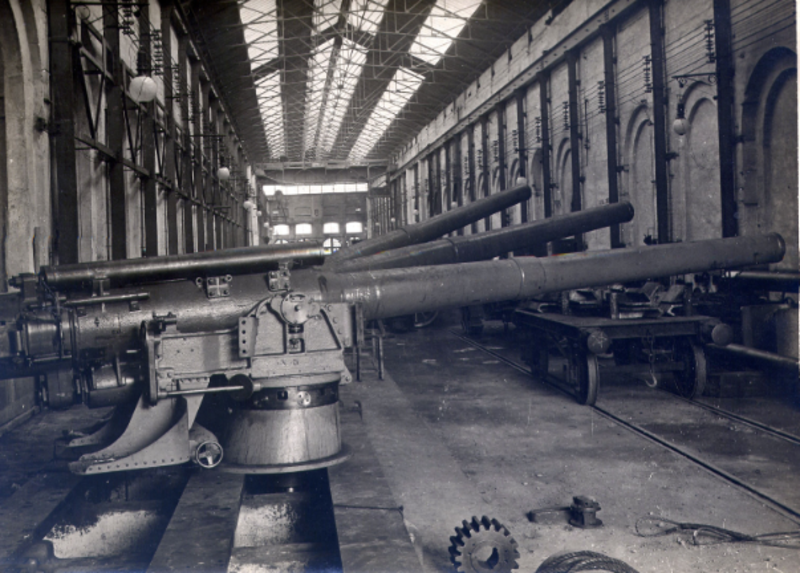
The secondary armament of the ships was planned to be eighteen and then only twelve Cannone navale da 152/50 (6 in) guns, 6-inches guns of Italo-British design. They were still quite a heavier, longer range caliber compared to the 135 mm of the Doria class.
They were classically mounted in casemates, clustered amidships in the battery deck which opened in two series broadly forward covering well the weather deck. This ensured six in chase, retreat and on broadside as well.
It should be said that these casemate guns did not made unanimity. Some Italian engineers (Like General Ferretti) defended turrets instead, placed above the deck and less subject to water spray, as well as a greater arc of fire fore and aft. However experience of twin 6-in turrets in 1913 was limited and pose problems of its own, notably the size of wings barbettes and complications for loading and citadel protection. They fired 50-kilogram (110 lb) AP or HE shells at a muzzle velocity of 850 meters per second (2,800 ft/s), one roudn a minute, and a mount allowing a 20° elevation max, making for a range of 19.4 km (12 mi). They could traverse 60 degrees and also depress to −5 degrees and were still “wet” in heavy seas as waves crashing on the foredeck could reach all the way to the battery. Instead of placing them in the hull instead, which would have force to raise the whole hull (and increase weight), this was a sensible weight-saving solution. Superstructure casemates seems also a new tendency in 1912-14, in France and Germany also.
DP/AA/light Guns
The anti-torpedo armament was to comprise originallt standard 57 and 47 mm, probably Arsmtrong and Hotchkiss. But in 1914 it was entirely revise and boldly, dual purpose armament with good anti-aircraft capabilities was chosen with eight Cannone da 102/45 (4 in)/45 guns. These were a rather modern Franco-British design from Amstrong-Schneider, as both countries were looking at the same type dual puspose gun in WWI. The Cannone 102/45 was in tuen licensed copy of the QF 4 inch Mk V, using a horizontal or vertical sliding breech block and semi-automatic action, fixed quick-fire ammunition. They fired a 13.75-kilogram (30.3 lb) unitary HE shell at 850 meters per second (2,800 ft/s) wich could reach 15 kilometres (9.3 mi) at +35° against ships and had a ceiling of 8,000 m (26,000 ft). They could have shattered any biplane of the time, being able in addition of 7rpm, so seven volleys for each main and secondary battery shots. These were located either on the main turrets and/or battery deck roof.
This was further reinforced by twelve 40-millimeter (1.6 in) guns, essentially British Bofors equivalents (QF 2-pdr) which was well complementing the 102 mm guns. These were essentially the same as the British models, made under licence by Ansalso as the ships were built in 1917. Same performances, short range but very high rate of fire. They were presumably to be located on the the main turrets (eight) and the remainder four in the bridge structure or deck. Indeed the smaller calibers are nor shown in plans.
Torpedoes
As was typical for capital ships of the period, the Francesco Caracciolo class were also given their initially planned eight torpedo tubes. These were either 450 mm (17.7 in) or 533 mm (21 in) in diameter. This has no tbeen clarified. The exact type is not known either. Read more.
⚙ F. Caracciolo super-dreadnoughts specifications |
|
| Displacement | 31 400 – 34 000 T. FL (33,000 long tons full load) |
| Dimensions | 212 x 29,6 x 9,5 m (696 ft x 97 ft 1 in x 31 ft 2 in) |
| Propulsion | 4 shafts Parsons turbines, 20 Yarrow boilers, 105,000 shp (78,000 kW) |
| Speed | 28 knots (52 km/h; 32 mph) |
| Range | 8,000 nmi (15,000 km; 9,200 mi) at 10 knots (19 km/h; 12 mph) |
| Armament (1917) | 8 x 381 (4×2), 12 x 152, 8 x 102, 12 x 40, 8 x 533 mm TTs sub |
| Protection | Belt 303, Decks 40, Blockhaus 400, turrets 400, casemates 220 mm |
| Crew | 1400 |

Caracciolo – author’s illustration
Construction and Fate
From the entry of Italy into the war in April 1915, priorities were entirely reshuffled by the Admiralty. The latter wanted construction of lighter units more economical and faster to build to cover the needs notably of interdicting the Adriatic to the Austro-Hungarian Navy and operate in the confines of the Ionian sea against the Turks. The maintenance and repair of existing units was soon also completely overruling congoing construction, especially four ships as complex, ciostly and cost-intensive as the Caracciolo class. They were no longer relevant in the new context. Entente Navies indeed had a clear advantage in battleships over the central empires, making the acceptance of new battleships even less desirable in the immediate context of the time.
The construction of the four Caracciolo was thus officially suspended in March 1916. Shortages of steel slowed their construction already before Italy entered the war, and after being suspended it was estimated that 9,000 t (8,900 long tons) of steel had been assembled for Francesco Caracciolo alone at this point. On her side, Cristoforo Colombo had just seen 12.5 percent of her hull completed, 5 percent of the machinery assembled. It was even far less for the remainder two, below 8%. Apart the bottom plates aroud the keel and some framing, little more was assembled. Two of the heavy guns intended from Cristoforo Colombo were soon removed and shipped to be installed aboard the monitor Faà di Bruno, those from Alfredo Cappellini coming from Francesco Morosini, the two Monte Santo and four Monte Grappa-class monitors having the remaining ones. The Regia Esercito also took delivery of four Cannone da 381/40 AVS railroad guns for its opetations on the Isonzo front, the remaining spare gns being pressed into coast-defense fortifications, notably around venice.
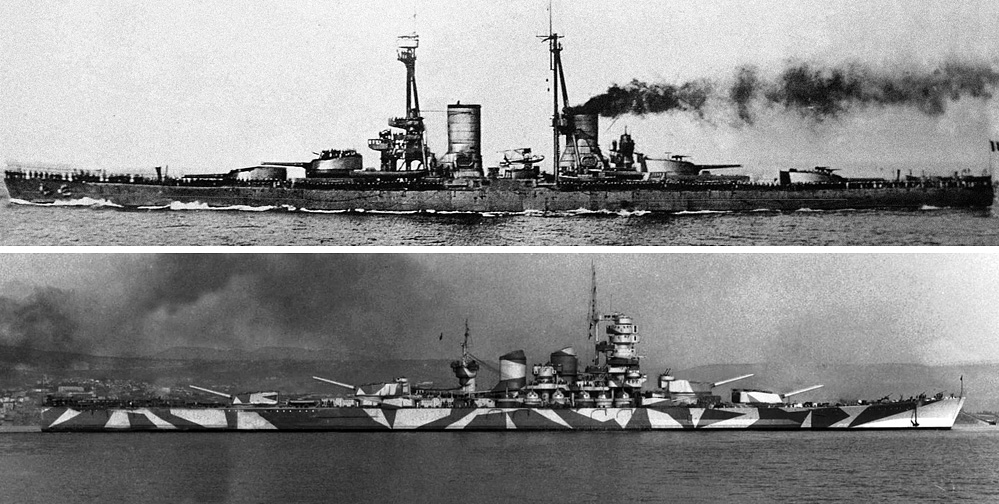
A nice what-if of the Caracciolo if completed and in service in 1940-43 SRC
RN Caracciolo herself, whose commissioning was originally planned to happen in late 1917 was still impressive on paper and no decision was taken about her fate and of her sister still in the slipways. Too much has been built to justify their demolition, other than that a particular need of steel. Which never presented this emergency until 1918. In 1919, Italy entirely reassessed her priority again. The cost of the war and prominent pacifism of the time precluded any “large fleet” plans and the admiraklty itself was still digestin the lessons of WWI before choosing any future orientation. The situation was also still “volatile”, especially in the Balnkans with the recent creation of Yugoslavia, a civil war in Turkey and conflict with Greece.
At least, the international context brought a fast decision: The treaty of Washington not only capped the Italian Tonnage, it also excluded completion of new battleships, even those planned before the war. France was in no better shape with her four Normandie class either. However the path taken was not to convert the completed hull as an aircraft carrier, as France did with the Bearn. The Admiralty was rather conservative towards the idea of using carriers.
When the official cancellation occurred, 9,000 tons of the Carracciolo hull had been assembled already and its new owner, the “Navigazione Generale Italiana”, proposed a reconversion into a civilian ships, ideally a liner. She was purchased, launched in October 1920 for a future completion. But the conversion project into a liner on the engineering point made little sense, and it was seemed in the end not realistic, dropped afterwards. There has been discissions about a conversion as an aicraft carrier (see later), but in the end, the admiralty wanted quality steel for its new heavy cruisers and decided to have all four scrapped on their slipways for the last three, and the hull of Caracciolo dismantled. Their precious artillery was kapt where it wa sinstalled until WW2, and that included the twin turret on Faa’ di Bruno.
1919: The construction is relaunched
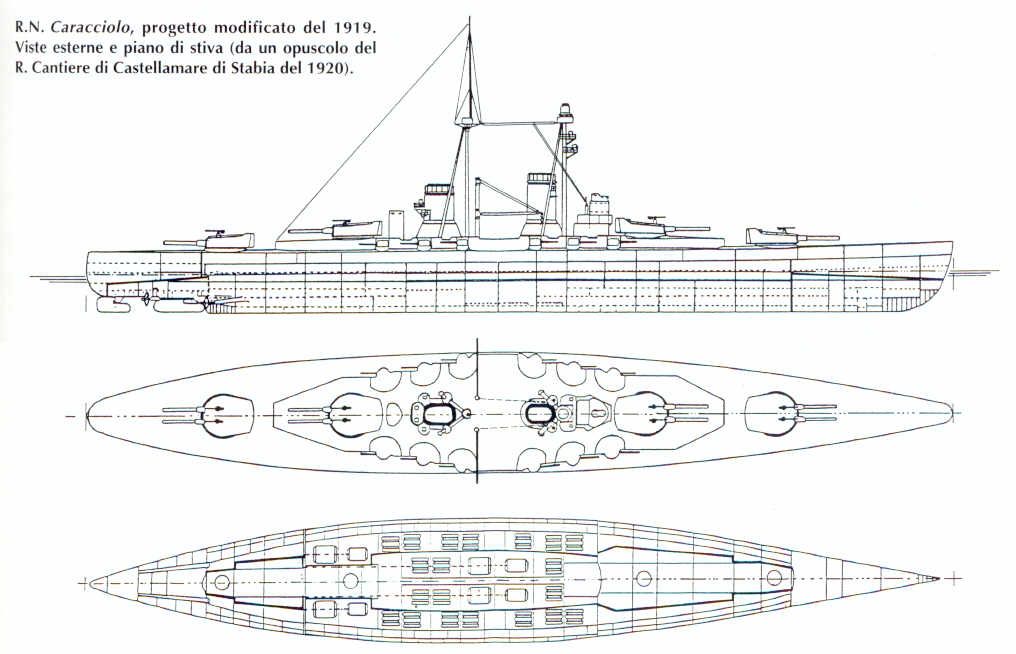

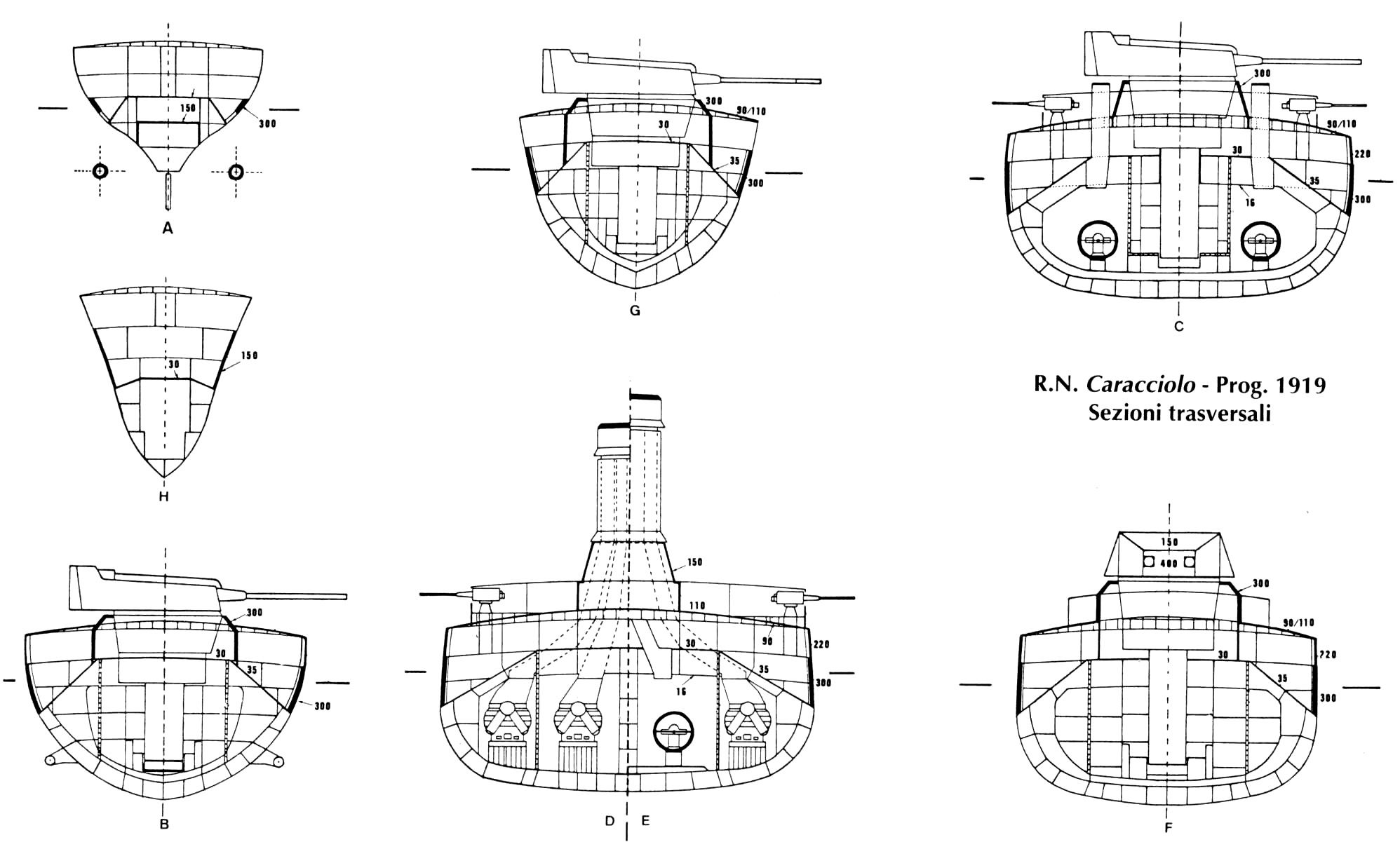
Revised design in 1919 src: Le navi da battaglia classe “Caracciolo”, A Mascolo, Storia Militare. via https://stefsap.wordpress.com.
Work resumed on Francesco Caracciolo in October 1919 but completion was still far away. Not only resourcves but also manpower was lacking. The Regia Marina however considered a flush-decked aircraft carrier conversion (like HMS Argus), but in 1919 the poor economic situation of Italy and the soon costly Italian pacification campaigns in Libya saw the naval budget curtailed. In 1919 ship’s design specs were: 31.400 tons standard, 34.000 tons full load, 212,08 m x 29,6 m x ,50 m draught, 20 Yarrow boilers, 4 Parsons turbine, 70.000 HP up to 105.000 HP forced, 8,0000 miles ranges based on 1,800 oil tons, same armamenr but eight 102mm/35 AA and sixteen 40mm/39 QF, main belt 300 mm (max vertical) and 90 mm to 110mm for the armored decks and horizontal protection in general).
The last-ditch aircraft carrier conversion project
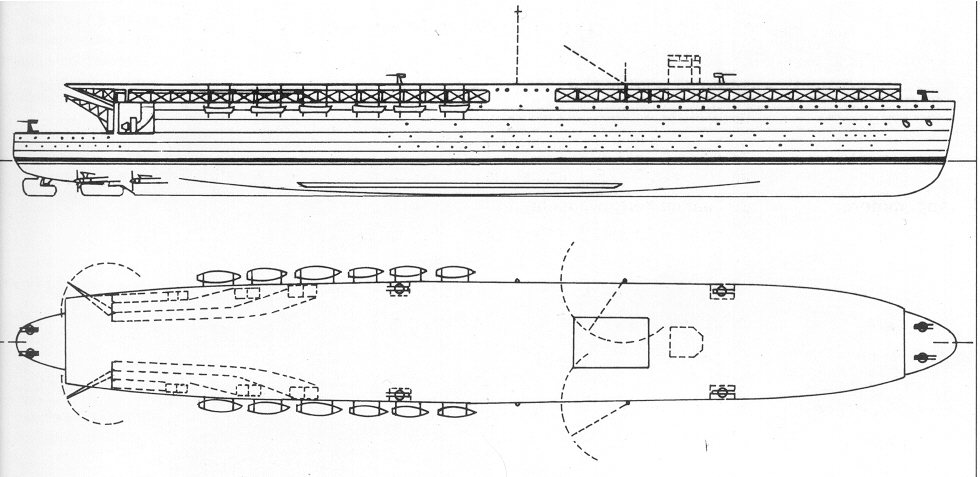
The first conversion project of Caracciolo in 1920.
In 1919, the Regia Marina considered the idea of converting her into an aircraft carrier (see also Italian interwar carrier projects). Duing negotiations at the Washington Naval Conference the 61,000 metric tons (60,000 long tons) battleship limit now included a converted Francesco Caracciolo and newly purpose-built ships. But still, limits on aicraft carriers were left open. Inexistant limits under 10,000 tonnes, and some global tonnage. Thus, a new conversion design was prepared, this time, not “flush deck”, but more mature. In between before the Washington treaty was signed, the Ansaldo shipyard still proposed converting Francesco Caracciolo into a floatplane carrier which was a cheaper alternative. But even this was too expensive for the Regia Marina in 1920.
In 1922, the new design examined by the Regia Marina was featuring an island superstructure, and specially prepared for Francesco Caracciolo. It receive a favouable overview, but again, chronic budgetary problems led to a thord cancellation.
Ultimate Fate
As well as budgetary problems, the senior Italian navy commanders could not agree on the shape of the post-war Regia Marina, with one faction advocating for aa traditional surface battle fleet, while a second (Romeo Bernotti, his assistant and Giuseppe Fioravanzo) believed in a fleet composed of aircraft carriers and small vessels such as torpedo boats, and submarines. The third faction was led by Admiral Giovanni Sechi. Her argued that a balanced fleet was ideal: A core of battleships and carriers seemed the most flexible composition. In this, he was right; although many still saw carriers like “screening auxiliaries” for the fleet. The other issue was absolute control of the Regia Aeronautica which prevented the birth of an independent naval aviation in Italy to its great detriment in WW2.
To secure budgetary space for new construction however, Admiral Sechi had to make axe cuts into the older ships still in service, cancelling altogether the Francesco Caracciolo class. Francesco Caracciolo was sold on 25 October 1920 to the Navigazione Generale Italiana shipping company in an attempt of a last-ditch trade reconversion. She was to be converted into a fast merchant ship, probably a mix of liner and cargo carrier, but the work was deemed too expensive for engineering reasons. So she was temporarily mothballed in Baia Bay outside Naples. Eventually returned to the Navy, the latter mothballed her untilk finding a company that can proceed to broken her up for scrap, which started by late 1926. Her other three sister ships had been long dismantled, in 1919-20. Machinery from Cristoforo Columbo however was at least recycled into the new prestige ocean liner Roma…
Read More
Books
Fraccaroli, Aldo (1974). Italian Warships of World War II. London: Ian Allan Publishing.
Campbell, John (1985). Naval Weapons of World War Two. Naval Institute Press. ISBN 0-87021-459-4.
Friedman, Norman (2011). Naval Weapons of World War One. Barnsley, South Yorkshire, UK: Seaforth.
John Gardiner Conway’s all the world’s fighting ships 1905-1921
Cernuschi, Enrico & O’Hara, Vincent P. (2007). “Search for a Flattop: The Italian Navy and the Aircraft Carrier 1907–2007”. In Preston, Anthony (ed.). Warship. NIP
Clerici, Carlo; Robbins, Charles B. & Flocchini, Alfredo (1999). “The 15″ (381mm)/40 Guns of the Francesco Caracciolo Class Battleships”. Warship International.
Fraccaroli, Aldo (1985). “Italy”. In Gray, Randal (ed.). Conway’s All the World’s Fighting Ships 1906–1921. NIP
Friedman, Norman (2011). Naval Weapons of World War One: Guns, Torpedoes, Mines and ASW Weapons of All Nations; An Illustrated Directory. Seaforth Publishing.
Goldstein, Erik & Maurer, John H. (1994). The Washington Conference, 1921–22: Naval Rivalry, East Asian Stability and the Road to Pearl Harbor. Routledge.
Ordovini, Aldo F.; Petronio, Fulvio; et al. (2017). “Capital Ships of the Royal Italian Navy, 1860–1918: Part 4: Dreadnought Battleships”. Warship International. LIV (4)
Romanych, Marc & Heuer, Greg (2017). Railway Guns of World War I. London: Osprey Publishing.
Sandler, Stanley (2004). Battleships: An Illustrated History of Their Impact. Santa Barbara: ABC-CLIO.
Silverstone, Paul H. (1984). Directory of the World’s Capital Ships. New York: Hippocrene Books.
Zabecki, David T. (1999). World War II in Europe. New York: Garland Publishing.
Links
https://en.wikipedia.org/wiki/Francesco_Caracciolo-class_battleship
https://www.marina.difesa.it/noi-siamo-la-marina/mezzi/mezzi-storici/Pagine/ABCD/caracciolo3.aspx
https://it.wikipedia.org/wiki/Classe_Francesco_Caracciolo
https://stefsap.wordpress.com/2016/10/01/francesco-caracciolo-class-battleships/
http://www.navweaps.com/Weapons/WNIT_Main.php
3D
Note: I am not aware of any model maker making the Caracciolo.
A 3D reconstitution of a “modernized WW2 Caracciolo by world of warships


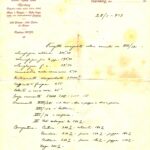
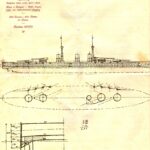
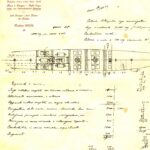
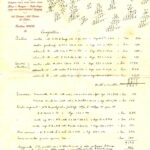
 Latest Facebook Entry -
Latest Facebook Entry -  X(Tweeter) Naval Encyclopedia's deck archive
X(Tweeter) Naval Encyclopedia's deck archive Instagram (@navalencyc)
Instagram (@navalencyc)





 French Navy
French Navy Royal Navy
Royal Navy Russian Navy
Russian Navy Armada Espanola
Armada Espanola Austrian Navy
Austrian Navy K.u.K. Kriegsmarine
K.u.K. Kriegsmarine Dansk Marine
Dansk Marine Nautiko Hellenon
Nautiko Hellenon Koninklije Marine 1870
Koninklije Marine 1870 Marinha do Brasil
Marinha do Brasil Osmanlı Donanması
Osmanlı Donanması Marina Do Peru
Marina Do Peru Marinha do Portugal
Marinha do Portugal Regia Marina 1870
Regia Marina 1870 Nihhon Kaigun 1870
Nihhon Kaigun 1870 Preußische Marine 1870
Preußische Marine 1870 Russkiy Flot 1870
Russkiy Flot 1870 Svenska marinen
Svenska marinen Søværnet
Søværnet Union Navy
Union Navy Confederate Navy
Confederate Navy Armada de Argentina
Armada de Argentina Imperial Chinese Navy
Imperial Chinese Navy Marinha do Portugal
Marinha do Portugal Mexico
Mexico Kaiserliche Marine
Kaiserliche Marine 1898 US Navy
1898 US Navy Sovietskiy Flot
Sovietskiy Flot Royal Canadian Navy
Royal Canadian Navy Royal Australian Navy
Royal Australian Navy RNZN Fleet
RNZN Fleet Chinese Navy 1937
Chinese Navy 1937 Kriegsmarine
Kriegsmarine Chilean Navy
Chilean Navy Danish Navy
Danish Navy Finnish Navy
Finnish Navy Hellenic Navy
Hellenic Navy Polish Navy
Polish Navy Romanian Navy
Romanian Navy Turkish Navy
Turkish Navy Royal Yugoslav Navy
Royal Yugoslav Navy Royal Thai Navy
Royal Thai Navy Minor Navies
Minor Navies Albania
Albania Austria
Austria Belgium
Belgium Columbia
Columbia Costa Rica
Costa Rica Cuba
Cuba Czechoslovakia
Czechoslovakia Dominican Republic
Dominican Republic Haiti
Haiti Hungary
Hungary Honduras
Honduras Estonia
Estonia Iceland
Iceland Eire
Eire Equador
Equador Iran
Iran Iraq
Iraq Latvia
Latvia Liberia
Liberia Lithuania
Lithuania Mandchukuo
Mandchukuo Morocco
Morocco Nicaragua
Nicaragua Persia
Persia San Salvador
San Salvador Sarawak
Sarawak Uruguay
Uruguay Venezuela
Venezuela Zanzibar
Zanzibar Warsaw Pact Navies
Warsaw Pact Navies Bulgaria
Bulgaria Hungary
Hungary

 Bundesmarine
Bundesmarine Dutch Navy
Dutch Navy Hellenic Navy
Hellenic Navy Marina Militare
Marina Militare Yugoslav Navy
Yugoslav Navy Chinese Navy
Chinese Navy Indian Navy
Indian Navy Indonesian Navy
Indonesian Navy JMSDF
JMSDF North Korean Navy
North Korean Navy Pakistani Navy
Pakistani Navy Philippines Navy
Philippines Navy ROKN
ROKN Rep. of Singapore Navy
Rep. of Singapore Navy Taiwanese Navy
Taiwanese Navy IDF Navy
IDF Navy Saudi Navy
Saudi Navy Royal New Zealand Navy
Royal New Zealand Navy Egyptian Navy
Egyptian Navy South African Navy
South African Navy






























 Ukrainian Navy
Ukrainian Navy dbodesign
dbodesign